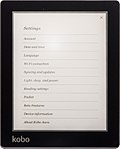E-book
An electronic book (also called an e-book, ebook, or digital book) is a book in digital form.[1] E-books can be read on computers or other electronic devices such as e-book readers. E-book readers, such as the Amazon Kindle, the Kobo eReader and the Barnes and Noble Nook are devices that are dedicated to showing e-books.[1]
History
The first e-book might have been the Index Thonisticus, a heavily annotated electronic index to the works of Thomas Aquinas made by Roberto Busa in the late 1940s. However, this is sometimes not called an ebook because the digital text was (at least at first) meant to develop an index and concordance, rather than as a published edition in its own right.
Despite the extensive earlier history, it is commonly reported that the inventor of the e-book is Michael S. Hart. In 1971, Hart was given extensive computer time by the operators of the Xerox Sigma V mainframe at the University of Illinois. He created his first electronic document by typing the United States Declaration of Independence into a computer.
One early e-book was the desktop prototype for a proposed notebook computer, the Dynabook, in the 1970s at the Palo Alto Research Center: a general-purpose portable personal computer capable of displaying books for reading.
In 1992, Sony launched the Data Discman, an electronic book reader that could read e-books that were stored on CDs. One of the electronic publications that could be played on the Data Discman was called The Library of the Future.
Early e-books were generally written for specialty areas and a limited audience, meant to be read only by small and devoted interest groups. The scope of the subject matter of these e-books included technical manuals for hardware, manufacturing techniques and other subjects. In the 1990s, the general availability of the Internet made transferring electronic files much easier, including e-books.
The current eBook standard is the EPUB file. There are other proprietary formats like .MOBI, AZW, IBA and PDF.
Advantages
- E-books are searchable. You can easily search for any information in an e-book, instead of turning page after page.
- When you need certain information, you can get it immediately, by downloading an e-book.
- No trees are required to manufacture paper for the pages of ebooks.
- E-books can show links, for easy access to more information and related websites.
- E-books take up less space. You don't need a library or a room to store them. You can store hundreds and thousands of e-books on your computer.
- No prime cost of paper and transportation.
- Functional and convenient: it combines with much other software, make itself more functional and convenient.
- Easy for authors or publishers to revise or update the books.
- Individualization: different backgrounds, front covers, back covers etc., according to people's needs.
- Self publishing: Any one can write books and let people read them through Internet without publishing a paper book.
Disadvantages[2]
- eBooks aren’t good for your eyes and you will feel tired after you look at the screen for a long time.
- eBook readers require power. If there is a power outage and the batteries die, the user will not be able to access the book.
- e-readers have plastics and heavy metals, this is not good for the environment and is worse than paper.
- People can't get the special feeling that they can feel when they read a paper book.
- eBooks are often tied to a digital rights management platform that only offers a license to access the eBook and not direct ownership. Compatible e-readers or sharing of an ebook are disabled or are tightly controlled.
E-book Media
Reading an e-book on a third-generation Kindle
- Michael Hart and Gregory Newby at HOPE Conference.jpg
Michael S. Hart (left) and Gregory Newby (right) of Project Gutenberg, at Hackers on Planet Earth (HOPE) Conference, 2006
A woman reading a book using an e-reader
References
- ↑ 1.0 1.1 "Inside eBook readers", How it Works Book of Amazing Technology, Imagine Publishing, p. 150, 2011, ISBN 978-1-908222-0-84
- ↑ "Disadvantages of E-Books - IST432_SP10_TEAM10 - Confluence". wikispaces.psu.edu. Archived from the original on 2016-03-06. Retrieved 2012-05-07.
Other websites
| Wikimedia Commons has media related to Lua error in Module:Commons_link at line 62: attempt to index field 'wikibase' (a nil value).. |
- E-books "E-books copy editing" Archived 2018-09-03 at the Wayback Machine







